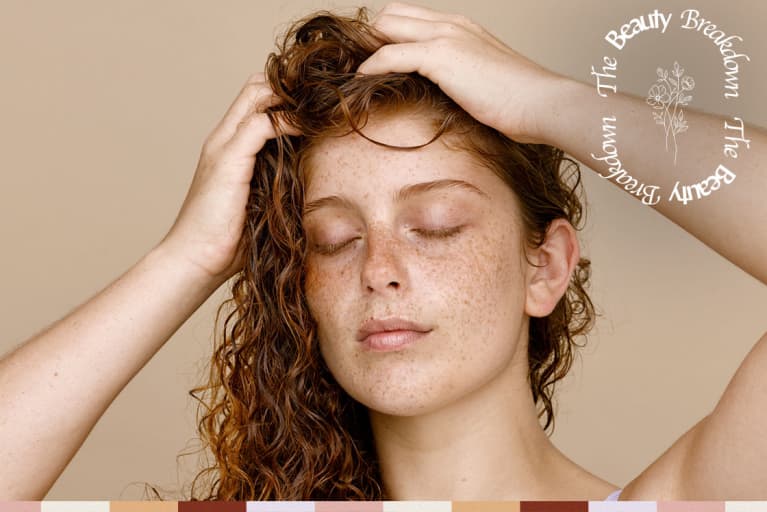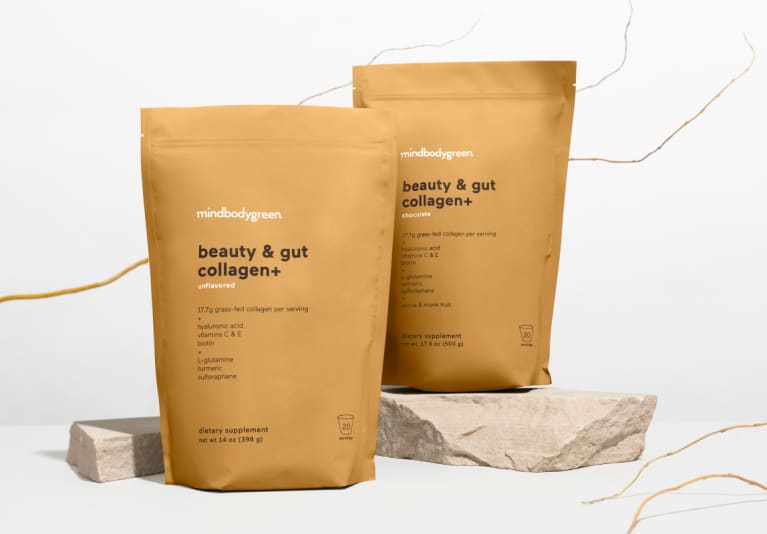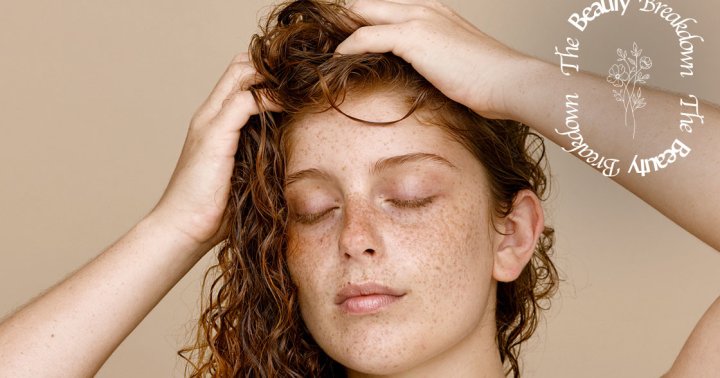
Welcome to the Beauty Breakdown, our series that dives into today’s buzziest beauty topics. In each, we focus on a different theme and highlight all the need-to-know basics, common mistakes, and the best products to get your hands on.
A few decades ago, using anything but soap and a simple lotion to cleanse and treat the face would have been viewed as excessive and unnecessary. Clearly, times have changed quite a bit. Skin care is the new normal, and it’s great to see younger generations prioritizing hygiene and self-care.
One area that’s recently entered the spotlight in this realm: the scalp. While many people equate a healthy scalp to healthy hair, there’s much more to this nuanced topic than meets the eye.
It is true that a healthy scalp encourages healthy hair, but that’s not all. The scalp is its own beast to tackle, and it requires much different care than the hair. In fact, you should view your scalp as an extension of the face rather than the base of your strands.
There are plenty of resources to learn about skin care routines, regimens, products, and treatments out there—but scalp care resources are lacking. Here, a full breakdown of everything you need to know about scalp care from the experts who study scalps and hair care product ingredients every single day.

Let’s start by clarifying one thing: Scalp care is not the same as hair care, and it shouldn’t be approached as such. As we said earlier, your scalp is an extension of your face, so it should really be treated more like basic skin care than hair care.
While your goal with hair care is to encourage strong, soft strands, you’re aiming for something completely different when it comes to the scalp. As certified trichologist and founder of scalp-first hair care brand Act+Acre Helen Reavey puts it, “The goal is to balance the scalp microbiome and keep it in homeostasis.”
When your scalp is healthy, the following processes can run smoothly:
- Nutrient delivery: When the hair follicle is cleared, you’re able to get nutrients from your hair care delivered to your scalp. When there’s excessive buildup around the follicle, however, your scalp can’t absorb the nutrients it needs to balance the microbiome and thrive.
- Hair growth: A healthy scalp encourages healthy hair growth. When there’s excessive inflammation, buildup, or dryness, the hair cannot grow properly.
- Hydration throughout the hair: If your hair is dry, your scalp is likely in a similar state and vice versa. Think of it like a chain reaction: Once you start prioritizing scalp care, your strands will benefit too.

5 things we’re getting wrong right now.
Even the most diligent skin and hair care devotees can have habits that may be working against them. Here, common practices that may be affecting your scalp:
- Not looking at the scalp enough: When you neglect regular check-ins with your scalp, you might miss the prime window for treating any problems before they get worse. It’s just like skin care: If you didn’t look at your skin in the mirror, you might miss a reaction to a product and continue using it until you’re experiencing a full-blown rash or other adverse reaction.
- Assuming flakes mean dandruff: If you take a look at your scalp and see flakes, you’ll probably assume it’s dandruff. The truth? It’s not that simple. Think of flakes on the scalp as a sign of something, but don’t jump the gun and assume it’s dead skin. More on that in a bit.
- Ignoring hair type: Different hair types call for slightly different approaches to scalp care. For example, those with curly hair should prioritize scalp hydration. “The diameter [of the follicle] is flat and ribbon-like, so it doesn’t retain moisture,” clean ingredient expert, founder, and CEO of Innersense Beauty Greg Starkman tells mbg. This means the scalp needs to be hydrated even more for those with curly strands.
- Equating scalp care to hair care: It’s a common misconception that products designed for the body of the hair should be used on the scalp as well. You may also think that scalp-focused products should be applied to the strands The two are not mutually exclusive, as the scalp is skin and the hair is, well, hair. Use dry shampoo on your strands, not your scalp. The same goes for cleansing shampoos.
- Pulling too hard: While the slicked-back ponytail may be having a moment, your scalp begs to differ. When the scalp is pulled back again and again, the damage is unavoidable. This can even lead to location-based hair loss at the base of the ponytail if done over time. This is called traction alopecia, and you can read more about it here.

The 6 steps you need to know:
beauty & gut collagen+
A powerful daily ritual for glowing skin and strong hair & nails*

When was the last time you really looked at your scalp? Certified trichologist and hair health expert Shab Reslan tells her clients: “Be a little bit more curious about the condition of your scalp.”
Reslan recommends sectioning the hair and looking closely at the scalp in the mirror. Ask yourself the following questions to guide your at-home scalp exam: Can I see product buildup around the follicle? Is there any redness or irritation? Are there any flakes?
“Flakes could mean that you have an oil buildup or the opposite, that you’re drying out your scalp. Or, it could be related to the environment or products you’re using,” she says. So it’s safe to say, using a dandruff shampoo the second you see a flake on the scalp isn’t going to solve every problem.
Because scalp care is skin care, you should be exfoliating weekly. There are a few different ways to exfoliate the scalp, and it’s worth trying out different methods to find which one is best for you. A few options:
- Scalp scrubs: To be clear, we’re not referring to harsh, large-rock-based salt scrubs. These can be too harsh on the skin and, like harsh physical face exfoliation, cause micro-tears and inflammation, Reavey explains. That being said, there are some gentler options that are worthwhile for getting rid of buildup (see below for our go-to scalp scrub).
- Chemical exfoliants: Salicylic acid is a common scalp exfoliator as it helps to eliminate buildup and regulate sebum production, thus helping to balance oily hair. A gentler exfoliating agent found in scalp cleansing products is glycolic acid.
That being said, if you’re not having any sort of irritation, itchiness, flaking, or oil imbalance, this kind of exfoliation may be unnecessary. Instead, you’ll want to opt for gentler detox products. Reslan says to keep these chemical exfoliants on the scalp and avoid running them through the rest of your hair as it’ll only dry out your strands.
Especially if you see dryness on your scalp or in your strands, using a hydrating product to replenish moisture after exfoliating is key. You wouldn’t use an exfoliating serum on your face without slathering on moisturizer after, and the same rule applies here.
Hair and scalp oils are different from scalp serums. The latter is meant to stay in your hair without feeling greasy or leaving residue. These serums can aid in hair growth, help combat dry patches on the scalp, and overall contribute to microbiome balance.
When you apply a scalp serum, do so to a clean scalp. Be sure to separate your hair with a comb and apply the serum to your entire scalp. After you apply, massage the serum into the scalp to ensure it absorbs. Pay special attention to any problem areas.
4. Give your scalp a break.
It’s not a crime to sport your favorite slicked-back style every now and then. Pulling on your scalp every day, however, isn’t the best idea. “Pulling back the hairline is going to be harsh because it puts a lot of pressure on the follicle,” Starkman says.
If you are taking proper care of your scalp, then these styles won’t be as dangerous, as your scalp will be stronger and more resilient. Nevertheless, try not to make this an everyday occurrence. Everyone’s scalp is different and thus, can tolerate different styles.
Simply pay attention to your scalp’s state, especially around the hairline and base of the ponytail or braid, to catch any early signs of hair loss if you want to continue wearing these styles safely.
There is so much power in your built-in tools. Giving yourself a scalp massage in the shower or with products before or after your rinse can work wonders. “Doing self-massage on the scalp promotes blood flow, which is relevant to natural oxygen in the body. This promotes healthier hair growth,” Starkman explains.
If you prefer a scalp massage tool instead, by all means, use what you like. Do note, however, that some of these massagers can be made of hard plastic and actually damage the skin on the scalp. Your hands can serve as an adequate tool that’s just as effective and less risky than using a hard, aggressive tool.
If you’re spending a long day in the sun, you should be protecting your scalp. You can certainly choose to wear a hat and provide a physical barrier, or you can opt for SPF on the scalp. This will help prevent sunburn, of course, but also keep your scalp microbiome happy, and as you now know, that’s the key to a healthy scalp.
There are tons of products on the market for this exact purpose—here’s a list of our top 8 scalp sunscreens for your browsing pleasure.
7. Know when to see a professional.
As is with skin care, sometimes at-home treatment just isn’t enough. If you are having severe scalp trouble, whether it be excessive and treatment-resistant flaking, irritation, or hair loss, it’s best to seek professional assistance.
You can visit a trichologist for a scalp examination or visit your dermatologist to discuss possible in-office treatments or, if necessary, prescription-grade products.

3 extra scalp-care steps for those looking to level up.
For those who want to take their routine beyond the basics:
This is a classic Ayurvedic tradition that can work wonders for a dry scalp. Find a clean and natural hair oil you love (one of our favorites listed below), and spend some time massaging the oil into your scalp.
Simply separate your hair into sections, run some oil down the part, massage, and repeat. This can be a mindful practice that doubles as a moment of peace and a dedicated act of self-care. If you can, leave the oil in your hair for a few hours or overnight to increase absorption.
2. Use silk or satin hair ties.
Like we said earlier, pulling the hair into extra-tight hairstyles can severely damage the scalp. Instead, opt for silk hair ties and scrunchies. This way, you can go for updos without worry as the satin won’t pull on the scalp as traditional, rubber hair ties would.
This will also help prevent breakage on the strand where the tie is fastened. This step serves as a best practice for your hair and for your scalp.
3. Don’t forget about in-salon treatments.
There are tons of scalp-focused treatments offered at hair salons. These range from hair growth to hydration to exfoliation-focused processes. Your hairstylist or trichologist will help you determine what your scalp needs at the time.

The best scalp care is holistic in nature—products included. Here, some of our favorites.
As we said, there’s much more to scalp care than meets the eye. From exfoliation to hydration and at-home massages, you can see why scalp care is more similar to skin care than hair care. If you’re not sure where to start, remember this: We don’t look at our scalps as much as we should, and your scalp will tell you what it needs if you give it the time and attention it deserves. If you follow these steps, you’ll be on the road to a balanced, comfortable scalp in no time.
Heal Your Skin.
Receive your FREE Doctor-Approved Beauty Guide
You are now subscribed
Be on the lookout for a welcome email in your inbox!
https://www.mindbodygreen.com/articles/scalp-care

